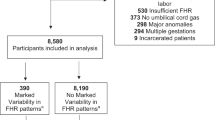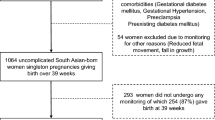ABSTRACT
Objective
Determine the association between electronic fetal monitoring and neonatal outcomes in the setting of a true knot at delivery.
Study design
This was a planned secondary analysis of a prospective cohort of 8580 women. Patients with and without a true knot were compared and the primary outcome was repetitive late decelerations occurring with at least 50% of contractions. Confounders were adjusted for using logistic regression.
Results
A total of 8580 patients met inclusion criteria and 49 (0.57%) had a TK. There was no significant difference in the rate of repetitive late decelerations in patients with TK (aOR 1.04; 95% confidence interval [CI] 0.25–4.40),other electronic fetal monitoring parameters, or neonatal outcomes.
Conclusion
Neonates with true knots who are delivered at term have similar electronic fetal monitoring characteristics compared to those without true knots and no detectable difference in neonatal morbidity; thus, calling into question the clinical significance of a true knot at term.
This is a preview of subscription content, access via your institution
Access options
Subscribe to this journal
Receive 12 print issues and online access
$259.00 per year
only $21.58 per issue
Buy this article
- Purchase on Springer Link
- Instant access to full article PDF
Prices may be subject to local taxes which are calculated during checkout
Similar content being viewed by others
References
Airas U, Heinonen S. Clinical significance of true umbilical knots: a population based analysis. Am J Perinatol. 2002;19:127–32.
Hershkovitz R, Silberstein T, Sheiner E, Shoham-Vardi I, Holcberg G, Katz M, et al. Risk factors associated with true knots of the umbilical cord. Eur J Obstet Gynecol Reprod Biol. 2001;98:36–39.
Joura EA, Zeisler H, Sator MO. [Epidemiology and clinical value of true umbilical cord knots]. Wien Klin Wochenschr. 1998;110:232–5.
Sørnes T. Umbilical cord knots. Acta Obstet Gynecol Scand. 2000;79:157–9.
Räisänen S, Georgiadis L, Harju M, Keski-Nisula L, Heinonen S. True umbilical cord knot and obstetric outcome. Int J Gynaecol Obstet. 2013;122:18–21.
Maher JT, Conti JA. A comparison of umbilical cord blood gas values between newborns with and without true knots. Obstet Gynecol. 1996;88:863–6.
Sopracordevole F, Perissinotto MG. [True knots in the umbilical cord: clinical implications]. Minerva Ginecol. 1991;43:109–13.
Gembruch U, Baschat AA. True knot of the umbilical cord: transient constrictive effect to umbilical venous blood flow demonstrated by Doppler sonography. Ultrasound Obstet Gynecol. 1996;8:53–56.
Roberts RN. Combined simple and complex cord knots. Eur J Obstet Gynecol Reprod Biol. 1995;62:131–3.
Minas V, Pilsniak A. An uncommon compound umbilical cord knot. J Obstet Gynaecol. 2011;31:183–4.
Polis RL, Santolaya-Forgas J, Tong C, Onieal G, Canterino JC, Matta PG, et al. Personalized medicine in a patient with the antenatal diagnosis of an umbilical cord knot and a previous adverse outcome for this reason. J Ultrasound Med. 2014;33:735–6.
Cahill AG, Tuuli MG, Stout MJ, Lopez JD, Macones GA. A prospective cohort study of fetal heart rate monitoring: deceleration area is predictive of fetal acidemia. Am J Obstet Gynecol. 2018;218:523.e1–12.
American College of Obstetricians and Gynecologists.. ACOG Practice Bulletin No. 101: ultrasonography in pregnancy. Obstet Gynecol. 2009;113:451–61.
Expert Committee on the Diagnosis and Classification of Diabetes Mellitus. Report of the expert committee on the diagnosis and classification of diabetes mellitus. Diabetes Care. 2003;26(Suppl 1):S5–20.
ACOG. Hypertension in pregnancy. Report of the American College of obstetricians and gynecologists’ task force on hypertension in pregnancy. Obstet Gynecol. 2013;122:1122–31.
Alexander GR, Himes JH, Kaufman RB, Mor J, Kogan M. A United States National reference for fetal growth. Obstet Gynecol. 1996;87(2 I):163–8.
American College of Obstetricians and Gynecologists. ACOG Practice Bulletin No. 106: Intrapartum fetal heart rate monitoring: nomenclature, interpretation, and general management principles. Obstet Gynecol. 2009;114:192–202.
Macones GA, Hankins GD, Spong CY, Hauth J, Moore T. The 2008 National Institute of Child Health and Human Development workshop report on electronic fetal monitoring: update on definitions, interpretation, and research guidelines. Obstet Gynecol. 2008;112:661–6.
Hennessy JP. True knots of the umbilical cord. Am J Obstet Gynecol. 1944;48:528–36.
Blickstein I, Shoham-Schwartz Z, Lancet M. Predisposing factors in the formation of true knots of the umbilical cord-analysis of morphometric and perinatal data. Int J Gynaecol Obstet. 1987;25:395–8.
Acknowledgements
Funding
This study is supported by the National Institute of Child Health and Human Development (NICHD) grant number R01H@061619-04 (PI: AGC). EBC was supported by a NIH T32 training grant (5T32HD055172-05) and the Robert Wood Johnson Foundation #74250.
Author information
Authors and Affiliations
Corresponding author
Ethics declarations
Conflict of interest
The authors declare that they have no conflict of interest.
Rights and permissions
About this article
Cite this article
Carter, E.B., Chu, C.S., Thompson, Z. et al. True knot at the time of delivery: electronic fetal monitoring characteristics and neonatal outcomes. J Perinatol 38, 1620–1624 (2018). https://doi.org/10.1038/s41372-018-0250-4
Received:
Revised:
Accepted:
Published:
Issue Date:
DOI: https://doi.org/10.1038/s41372-018-0250-4



